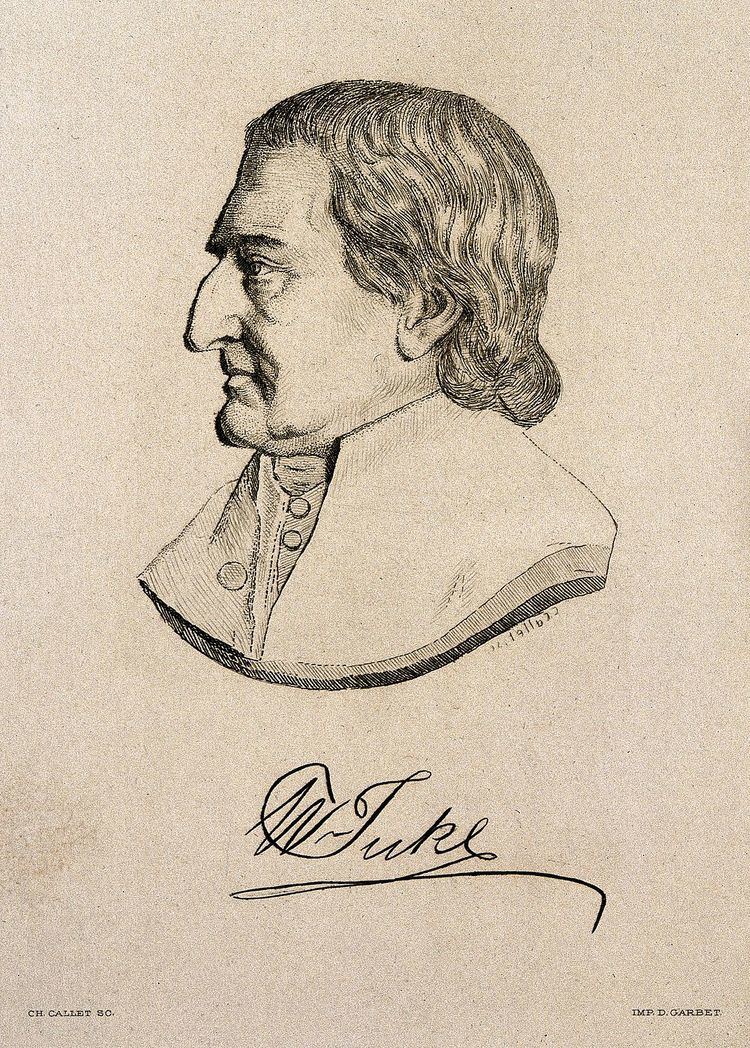Name William Tuke | Role Businessman | |
 | ||
Died 1822, York, United Kingdom | ||
William Tuke (24 March 1732 – 6 December 1822) was an English businessman, philanthropist and Quaker. He was instrumental in the development of more humane methods in the custody and care of people with mental disorders, an approach that came to be known as moral treatment.
Contents

Early life
William Tuke was born on 24 March 1732 in York into a prominent Quaker family. His father, Samuel, was a stuff-weaver and shopkeeper who died when Tuke was 16. His mother, Ann, died seven years later. Tuke attended boarding school for two to three years after which he pursued further studies under clergymen. At age 14, he began an apprenticeship at his aunt’s wholesale tea business, which he inherited upon her death in 1752. Tuke married Elizabeth Hoyland in 1754 and fathered four children. After Elizabeth died giving birth of their fifth child, Tuke met and married Esther Maud in 1765. Tuke and his wife were deeply involved in the Friends community and advocated for stricter adherence to Quaker principles. For five decades, he travelled to London for Yearly Meeting and served as clerk at the 1783 meeting. During this time, Tuke remained involved in the family business alongside his eldest son and business partner, Henry.
The Retreat
In 1791, William Tuke was moved by an incident involving Hannah Mills, a melancholic Quaker widow who died unexpectedly at York Lunatic Asylum. Although the cause of her death was not determined, mistreatment was suspected, and the managers had forbade Mills from having any visitors. Tuke’s daughter, Ann, proposed the idea of an mental institution run by Quakers for their own members. At a Society of Friends meeting in March 1782, Tuke presented his plan for those who “laboured under that most afflictive dispensation – the loss of reason.” However, the proposal was met with significant opposition. Some members felt that the creation of such an institution was unnecessary, while others saw it as overstepping the jurisdiction of the Quaker community. A small minority of supporters included Tuke’s son, Henry, and grammarian Lindley Murray.
During a visit to St. Luke’s Hospital in London, Tuke witnessed the appalling conditions in which patients were kept. He was particularly affected by a naked, female patient who had been chained to a wall. Tuke believed that the abuse was not the result of cruel intent but rather a lack of effective alternatives.
By 1795, financial and social support from the community was still limited. The Society of Friends eventually approved the plan when Tuke’s friend, Lindley Murray, suggested raising funds through annuities. Tuke bought an 11-acre for £938 and worked closely with London architect John Bevans to carry out his vision for the new asylum. Unlike other institutions of the time, York Retreat featured long, airy corridors that allowed patients to take a stroll even if they were restricted from going outside. A month after the first patients arrived in June 1796, the unexpected death of superintendent Timothy Maud forced Tuke to step in and run the Retreat himself.
William Tuke allowed his doctors to make their own observations and apply them to their practice. Bleeding and other traditional remedies were abandoned in favor of gentler methods, such as warm baths for patients with melancholia. Tuke believed that physical and mental health were inextricably linked and emphasized the importance of a proper diet and exercise. He sought to instill a sense of reason, not fear, and limited the use of physical restraints. Patients were encouraged to make themselves comfortable and often took up jobs like sewing and knitting.
The approach was widely derided at first, and William Tuke noted that "All men seem to desert me." However, it became famous around the world as a model of more humane and psychologically-based approaches.
Other work
Outside his work at the Retreat, Tuke helped in founding three Quaker schools: Ackworth School, Bootham School, and Trinity Lane Quaker Girls’ School. The latter was run by Tuke’s second wife Esther until her death in 1794. The Tuke family continued to run the school until 1812, by which point 500 students had passed through it.
As a patron of the Bible Society, Tuke attended all of its meetings and contributed generous donations. Tuke campaigned against the slave trade and supported abolitionist William Wilberforce in the 1806 Yorkshire parliamentary election.
Tuke was one of a few voices in Britain opposing the East India Company for its inhumane impact on other countries. He was also a subscriber to the African Institution, the body which set out to create a viable, civilized refuge for freed slaves in Sierra Leone, Africa.
Towards the end of his career, a resurgence of patient abuse at the York Asylum prompted Tuke to take to the local press and demand urgent reform. Tuke provided evidence to the Select Committee on Madhouses in May 1815, which led to further inquiries and the passage of the County Asylums Act in 1828.
Final years and death
Tuke remained involved with the Retreat until he became blind at age 82. He died on 6 December 1822 after a paralytic attack.
Legacy
Four of Tuke’s family members pursued similar philanthropic work. His son Henry (1755–1815) co-founded the York Retreat. At Henry's request, his son Samuel (1784–1857) wrote an 1813 account on the Retreat and popularized the principles of ‘moral treatment’. Samuel’s son James Hack Tuke (1819–1896) also helped manage the York Retreat, while his brother Daniel Hack Tuke (1827–1895) co-wrote “A Manual of Psychological Medicine” (1858) and became a leading physician and expert in insanity.
